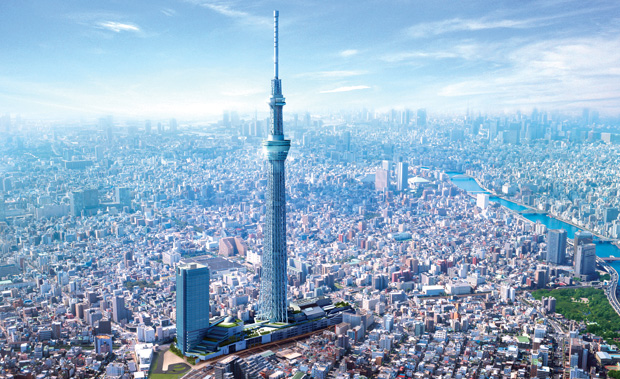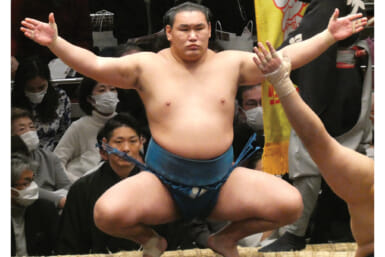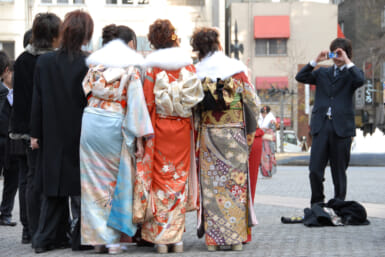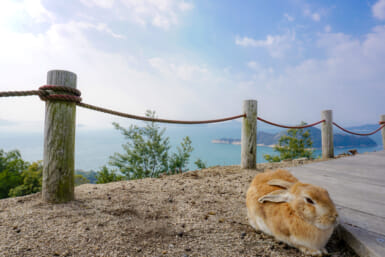Tokyo Sky Tree – Artists Impression
When it reaches its completed height of 634 meters, Tokyo Sky Tree will be amongst the tallest structures in the world. At halfway there it is already as tall as both the Eiffel Tower and the 1958 Roppongi landmark that it will replace. As cities like Beijing, Seoul and Dubai compete aggressively to stand out on the architectural map, what will be become of the original futuristic capital? On a quest to discover what the future holds for Tokyo and its skyline, I talked with some of Japan’s most innovative and renowned architects and designers.
The Only Way is Up
“What is fascinating about the Sky Tree is the reason they’re building it: expanding the reach of broadcasting,” commented Cédric Carêmel, a 27-year-old French graphic and concept designer working in Tokyo. “This means that Tokyo is building a gigantic vertical structure to balance its crazy horizontal expansion. And this is the logical evolution for such an organic city. Somehow, Tokyo is alive.”
Constantly being rebuilt and reinvented, Tokyo has become a landmark of urban design and the inspiration for countless books and films. In the new guide book 21st Century Tokyo, Julian Worrall writes that, “As early as 1972, Andrei Tarkovsky had found in the expressways of Tokyo material for his brooding epic Solaris; a decade later Ridley Scott’s Blade Runner projected imagery drawn straight from Shinjuku in 1981 to imagine Los Angles in 2019.”
Award-winning architect Edward Suzuki knows a few things about building in Japan. “Tokyo is unique compared to Europe and newer American cities in that the urban design restrictions are not as stringent as abroad—Japanese architects are free,” he said. But this is not necessarily always a positive thing. “The city needs to be addressed in terms of urban design,” Suzuki continued. “I think there is a lot to be learned from cities like Rome and Paris.”
 The futuristic JR Saitama Station, designed by Edward Suzuki
The futuristic JR Saitama Station, designed by Edward Suzuki
To tourists, Tokyo might look like a city with no rules, especially if you compare it to European city plans. As Carêmel pointed out, “In Paris, you have those long and absolutely straight boulevards—it’s impressive, but it’s boring. Here, it seems curved and twisted like a maze. No street names, just numbers, and it looks like the building are always switching and swapping. You discover a place—a building, a shop—and then you come back one year later and everything has suddenly disappeared, like in a dream.”
Innovations like the ubiquitous Shibuya crossing have achieved global acclaim, but how will new projects compare? Suzuki remarked, “I think Sky Tree is going to be like the Eiffel tower in its early stages. It’s going to be a great symbol, but now I’m thinking more in terms of the waterfront in itself—people are only just realizing that Tokyo is on the sea.”
 Award winning Architect Edward Suzuki
Award winning Architect Edward Suzuki
After Odaiba was developed from reclaimed land in Tokyo Bay, people could finally appreciate the cityscape from the other side. “There are promising signs of a very beautiful skyline for Tokyo, however, there are problems, sunshine problems and congestion,” said Suzuki. “I think Tokyo is overdeveloped, and I’m not sure this should continue. Cities ought to have an optimum size to be liveable; Kyoto is an example of the perfect size”
 Martin Van Der Linden, of Van Der Architects
Martin Van Der Linden, of Van Der Architects
As cities like Tokyo and London continue to be overdeveloped, the future may see these smaller cities gaining in importance. Many are aiming for the ‘Bilbao effect’ (in which one major building attracts thousands of visitors that otherwise wouldn’t bother with the city), so regions outside of Tokyo may see development. “In the future, cities will look for this effect; they will try to exploit their uniqueness, even if it is artificial,” said Martin van der Linden, founder of Van Der Architects.
Constant Change
Tokyo was nearly completely rebuilt twice in the past century, and this year iconic landmarks like the Kabuki-za theater and the fashion house of Hanae Mori will be destroyed and redeveloped. But is this constant renovation a good thing?
“Absolutely,” said Carêmel. “This model could not be exported to Europe for cultural reasons, but I think this specific point explains why the city is so economically active. If you know everything can collapse one day, then you just want to go ahead. You build, you change, you erase, you rebuild; just the human beings are important.”
Suzuki has thought deeply about this issue and believes it’s ultimately up to Tokyo’s citizens to decide. “Before we ask questions about preserving buildings, we should ask ourselves what is important for us and our city,” he said.
But overall, the consensus is generally that change can be positive as long as the people affected by the change are involved and consulted. “The Hanae Mori building was built yesterday as far as I’m concerned, and if [rebuilding] it changes [the building’s] image, it doesn’t bother me too much if they build a better one in its place,” Suzuki comments. His favorite street is Omotesando, which he describes as akin to an open air architecture museum. The ever-present Tokyo Union Church is a project with personal meaning for Suzuki, who entered the initial competition for the building’s redesign in 1982. “The old church was very picturesque; people would come and have their photograph taken in front of it. It was a landmark in the area, so I wanted to keep that landmark feel, [to create] something that has meaning,” he says.
Van der Linden is annoyed with the constant cleansing of cities, such as the war that is being waged against his favorite Tokyo neighborhood, Kabukicho. “A city should have its sleaze. My city, Maastricht, lost its grandeur; streets with dirt are now too clean and modernized. The ‘broken window’ theory [of crime] is true, but graffiti is also a resistance against conformity. In trying to control a city, you’ll end up like a Stalinist country.” Architects destroy to build, so regeneration can be both positive and negative. “I have always said it’s fine to remove something, but you have to put something back that’s better,” explains van der Linden.
 An office interior by Van Der Architects
An office interior by Van Der Architects
Sustaining the City
As the global population rises, you cannot open a newspaper or watch the news without hearing the terms ‘green,’ ‘eco,’ and ‘sustainable.’ This is becoming more and more true, even in technology- and convenience-loving Japan. But are these just empty slogans, or will ‘green’ architecture play a major role in Tokyo’s future?
“I think within a lot of architectural journalism this is [just] a trend, but it shouldn’t be. It’s the only way to preserve our towns and cities,” said Suzuki. He works by borrowing and learning from traditional Japanese architecture, in which houses were passive structures. Without machines to heat and cool them, they were necessarily planned to incorporate ventilation and natural sunlight. Suzuki said he is trying to relearn from the past, to “understand the principles and re-apply them with new materials.”
Designer Fumiko Kaneko of Ciel Rouge Creation (a firm that is behind numerous modern buildings across Japan and France) said that she aims to create spaces where people can “live, work and experience culture and leisure in harmony with nature at every level.”
Van der Linden is growing weary of the hype surrounding all things ‘green.’ “Sustainability is sexy jargon at the moment, and jargon that seems to work. I am not a skeptic—we have issues—but we need a new word! In comparison to other global capitals, Tokyo is a very ‘green’ city. Most people travel by train, and it’s very dense, unlike [cities in] the US, where [they are] spread so wide,” he said. “Tokyo has many points that make it much further advanced than others, and these are all the things that we will see in cities in the future.”
But although he doesn’t support the hype, Van der Linden does recognize that a fundamental change is necessary in order to sustain cities in the future. “I may be too pragmatic, but people are just jumping on the bandwagon,” he said. “What is necessary is a philosophical change. Slogans are like mission statements: lies on paper with a beautiful sunset behind them.”
Today the biggest cities in the world are in developing countries, such as Lagos in Nigeria, which the UN-Habitat says is the second fastest growing city in the world. Lagos once had 100,000 people; now its population numbers over fifteen million. This kind of density is difficult to sustain, but it may mean that world’s next great cities will be concentrated in what is now considered the developing world. “If we go back to [being] an agricultural society, the world can only sustain two billion people, so the only way to survive is in a city…a high density city, even higher density than Tokyo,” Van der Linden said.
So if you think Tokyo is busy and congested now, wait until the next crop of skyscrapers is built. If architects and urban planners make intelligent use of resources, Japanese cities may be able to continue competing with the world’s other booming metropolises. And this time, maybe ‘green’ will replace the dull grey of the concrete jungle.
Further Information
Edward Suzuki Architects: www.edward.net
Van Der Architects: www.vanderarchitects.com
Ciel Rouge Creation Architects: www.cielrouge.com
Tokyo Sky Tree: www.tokyo-skytree.jp
Photography
CG Photography of Sky Tree by; Tobu Railway Co.,Ltd and Tobu Tower Sky Tree Co.,Ltd
Construction of Sky Tree by; Ryota Aratashi, Materials provided by Nikken Sekkei Ltd.
Other photos by Edward Suzuki Associates and
Van Der Architects













